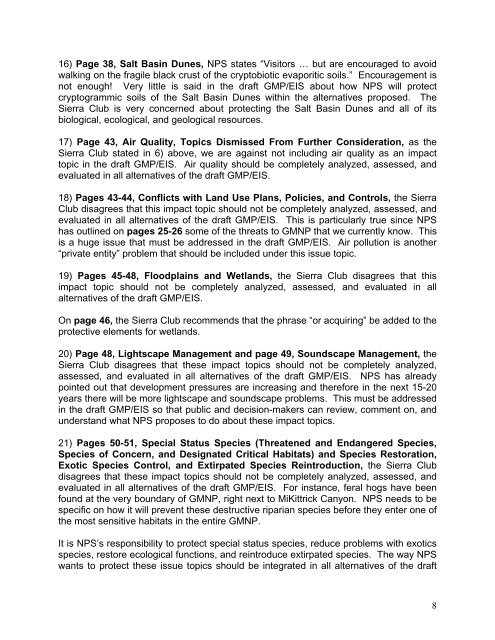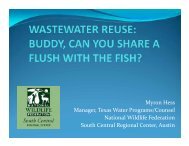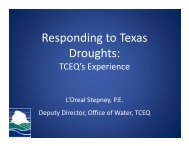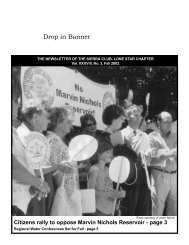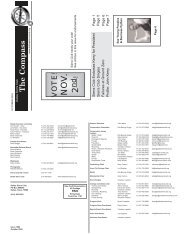comments in PDF - Lone Star Chapter, Sierra Club
comments in PDF - Lone Star Chapter, Sierra Club
comments in PDF - Lone Star Chapter, Sierra Club
You also want an ePaper? Increase the reach of your titles
YUMPU automatically turns print PDFs into web optimized ePapers that Google loves.
16) Page 38, Salt Bas<strong>in</strong> Dunes, NPS states “Visitors … but are encouraged to avoid<br />
walk<strong>in</strong>g on the fragile black crust of the cryptobiotic evaporitic soils.” Encouragement is<br />
not enough! Very little is said <strong>in</strong> the draft GMP/EIS about how NPS will protect<br />
cryptogrammic soils of the Salt Bas<strong>in</strong> Dunes with<strong>in</strong> the alternatives proposed. The<br />
<strong>Sierra</strong> <strong>Club</strong> is very concerned about protect<strong>in</strong>g the Salt Bas<strong>in</strong> Dunes and all of its<br />
biological, ecological, and geological resources.<br />
17) Page 43, Air Quality, Topics Dismissed From Further Consideration, as the<br />
<strong>Sierra</strong> <strong>Club</strong> stated <strong>in</strong> 6) above, we are aga<strong>in</strong>st not <strong>in</strong>clud<strong>in</strong>g air quality as an impact<br />
topic <strong>in</strong> the draft GMP/EIS. Air quality should be completely analyzed, assessed, and<br />
evaluated <strong>in</strong> all alternatives of the draft GMP/EIS.<br />
18) Pages 43-44, Conflicts with Land Use Plans, Policies, and Controls, the <strong>Sierra</strong><br />
<strong>Club</strong> disagrees that this impact topic should not be completely analyzed, assessed, and<br />
evaluated <strong>in</strong> all alternatives of the draft GMP/EIS. This is particularly true s<strong>in</strong>ce NPS<br />
has outl<strong>in</strong>ed on pages 25-26 some of the threats to GMNP that we currently know. This<br />
is a huge issue that must be addressed <strong>in</strong> the draft GMP/EIS. Air pollution is another<br />
“private entity” problem that should be <strong>in</strong>cluded under this issue topic.<br />
19) Pages 45-48, Floodpla<strong>in</strong>s and Wetlands, the <strong>Sierra</strong> <strong>Club</strong> disagrees that this<br />
impact topic should not be completely analyzed, assessed, and evaluated <strong>in</strong> all<br />
alternatives of the draft GMP/EIS.<br />
On page 46, the <strong>Sierra</strong> <strong>Club</strong> recommends that the phrase “or acquir<strong>in</strong>g” be added to the<br />
protective elements for wetlands.<br />
20) Page 48, Lightscape Management and page 49, Soundscape Management, the<br />
<strong>Sierra</strong> <strong>Club</strong> disagrees that these impact topics should not be completely analyzed,<br />
assessed, and evaluated <strong>in</strong> all alternatives of the draft GMP/EIS. NPS has already<br />
po<strong>in</strong>ted out that development pressures are <strong>in</strong>creas<strong>in</strong>g and therefore <strong>in</strong> the next 15-20<br />
years there will be more lightscape and soundscape problems. This must be addressed<br />
<strong>in</strong> the draft GMP/EIS so that public and decision-makers can review, comment on, and<br />
understand what NPS proposes to do about these impact topics.<br />
21) Pages 50-51, Special Status Species (Threatened and Endangered Species,<br />
Species of Concern, and Designated Critical Habitats) and Species Restoration,<br />
Exotic Species Control, and Extirpated Species Re<strong>in</strong>troduction, the <strong>Sierra</strong> <strong>Club</strong><br />
disagrees that these impact topics should not be completely analyzed, assessed, and<br />
evaluated <strong>in</strong> all alternatives of the draft GMP/EIS. For <strong>in</strong>stance, feral hogs have been<br />
found at the very boundary of GMNP, right next to MiKittrick Canyon. NPS needs to be<br />
specific on how it will prevent these destructive riparian species before they enter one of<br />
the most sensitive habitats <strong>in</strong> the entire GMNP.<br />
It is NPS’s responsibility to protect special status species, reduce problems with exotics<br />
species, restore ecological functions, and re<strong>in</strong>troduce extirpated species. The way NPS<br />
wants to protect these issue topics should be <strong>in</strong>tegrated <strong>in</strong> all alternatives of the draft<br />
8


